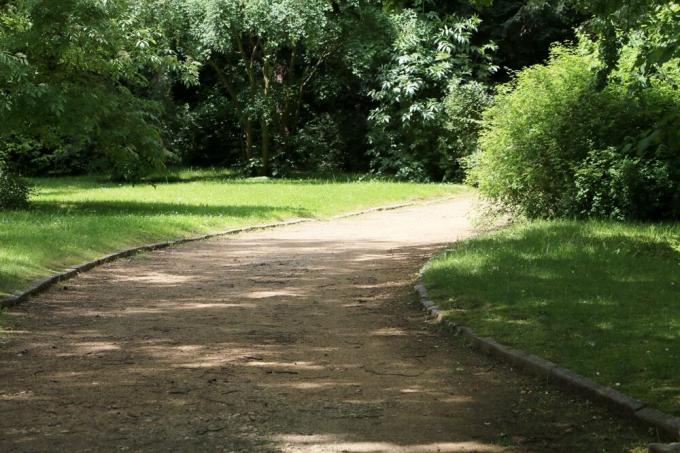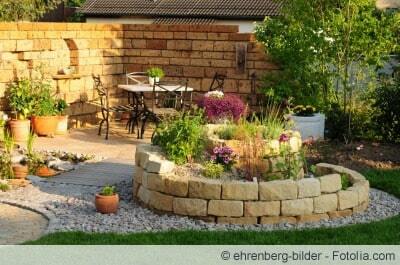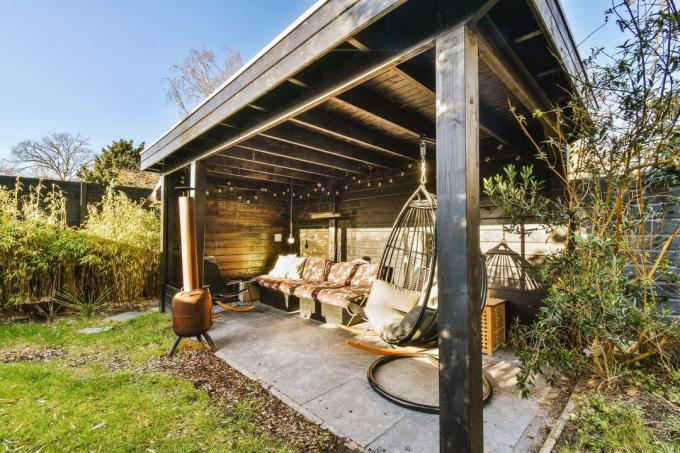

Table of contents
- concrete, sand or earth
- stones, costs
- choice, purchase
- material
- Preparation
- concrete
- Embarrassed
- The luxury variant
- Beautiful shapes
- hillside
- Conclusion
Lawn edging stones can be set in sand or concrete. Laying directly into the ground is also possible. However, if you want to prevent the stones from slipping over time, it is best to place them on a concrete foundation. In the long run, this prevents the stones from sinking. Don't worry, this work is easy to do even for an active layman. Below is the theoretical foundation, from selecting the right stones to mixing the right mixture.
concrete, sand or earth
A stable laying of the lawn edging stones in concrete is recommended
- if there is a large margin between the areas to be delimited
- when the soil is particularly loose
- when subsidence and other irregularities are to be prevented over time
- on slopes and when the boundary is also intended to protect against erosion
- in particularly large areas
- If they run directly along a paved path or a garage driveway
stones, costs
Stones made of concrete or granite are best suited for laying in concrete. Here everyone can decide according to their taste and budget. You have to reckon with costs of two to seven euros for the running meter of concrete blocks. It all depends on the quality and thickness of the stones. For granite stones you can spend 10 to 30 euros per meter. The larger the purchase quantity, the better the price offer will be.
choice, purchase
Before the selection can be made, the course of the lawn edge must be clear. Should it only be a straight border on one side, should the corners of the borders be square or rounded? You get a beautiful harmony with a curved border. This looks nice, but can cause problems when mowing the lawn. There is also the possibility of sinking the stones at ground level, then they can be driven on with the mower. As a rule, however, they end with the tip of the blade of grass. So, before visiting the hardware store, determine the number of meters required and note the number of corner stones and the curves. Small decision-making aid:
- Narrow stones are rather unsuitable for a high level difference between the adjacent sides. They lean slightly to the side.
- Smaller stones look nicer for demarcating bed sections.
- With curved lines, suitable stones must be selected for curves.
- Large and robust stones are to be chosen if they are to lead along a driveway or a frequently used path.
material
As before preparing an elaborate menu, it is also helpful when laying stones to have all the “ingredients” ready beforehand:
- lawn edging stones
- cutter
- Sand, coarse and fine gravel
- cement
- Water
- spade
- string, scissors
- rubber mallet
- trowel
- vat, bucket
- Tape measure, spirit level
Preparation
An edge is cut off vertically with a spade along the edge of the lawn. If straight lawn edges are planned, then it makes sense to mark the course with a string beforehand. A ditch is dug along this edge. The size depends entirely on the stones. After completing the work, the stones should stick out about four to five centimeters from the ground. For the standard stone size this will require a depth of around 70 cm and a width of approx. 50 cm.

This ditch is filled with roughly 10 cm of coarse gravel. The gravel must be carefully compacted (compacted). For the next layer, mix sand with fine gravel and distribute this mixture again 10 cm high on the first layer of gravel. Now it's time to carefully compact again.
concrete
Lean concrete is usually used for the foundation of lawn curbs. Lean concrete is earth-moist and has a lower cement content than normal concrete. It is usually used for laying curbs. For this purpose, the required amount can easily be produced by yourself. Either in a concrete mixer or in a square mortar vat. The usual and sufficient mixing ratio consists of five parts gravel (grain size 0.8 mm) to one part cement. An indication of the amount of water cannot be generally predicted. Roughly speaking, half a liter of water is used for one kilogram of cement.
First, the cement is mixed with the water to form a kind of glue, then the aggregate (gravel, sand) is added. It is better to start with less water at the beginning and add more water at the end if necessary. Exactly how much water is needed cannot be said in general terms. This also depends on the outside temperature, the humidity and the moisture content of the aggregate. For smaller concreting work, however, you are on the safe side with half a liter of water on one kilogram of cement.
Tip:
The required amount of lean concrete or Cement, depends on the respective volume. So length times width times height. Delivery of the concrete may not be worthwhile for this type of project. Those who mix themselves are also more independent in terms of time.
Embarrassed
The earth-moist concrete can now be applied to the compacted layer of gravel. Not too much, so that the stones don't stick out too high at the end, approx. they should stand five centimeters above the turf. The concrete must be thoroughly trampled down again before the first stone is set. This must be aligned carefully and preferably with a spirit level. Now you can stretch a cord again to be able to adjust the height of all other stones.
Tip:
During the entire concrete work, the area must be protected from heavy rain until the concrete has hardened. Otherwise the cement parts will be flushed out and the structure will lose stability.
The stones are placed on the concrete with a rubber mallet to the right height. A spirit level works well for this. Once all the lawn edging stones have been laid, give them even more stability by using a trowel to spread some concrete on the sides, right and left, as a wedge-shaped support. Finally, three quarters of the stones should be embedded in concrete. Now let the concrete harden for a day. Once the concrete has hardened, the trench can be backfilled with soil.
Tip:
There should be a small gap between the stones to protect the stones from cracking at the edges.
The luxury variant
If you want to be very comfortable when mowing the lawn, you can lay a row of flat paving stones next to the lawn edging stones. This keeps the lawn away from the curbs and you can easily drive one wheel of the mower along it. There is no need to trim the lawn curbs.
Beautiful shapes

In some gardens, a curved lawn edge fits better than a simple straight line. Lawn edging stones, for example, which have a curve (convex, concave) on both sides, are suitable for this. Of course, the cord as a guideline has had its day. Here you can mark the lines for the excavation quite well with a garden hose. For larger projects, it is advisable to lay out the stones with the desired curves in the grass. Don't be surprised, it will take a long time for the curved lines to create a harmonious whole. Then you can pierce the right and left of the stones with the spade. After that, the stones are put away and the excavation can begin.
hillside
On a hillside or with a steep incline, the lawn crotchets can be used in a cascade form. Since the ground exerts a lot of pressure on the stones here, we strongly recommend setting them in concrete.
Conclusion
That doesn't sound that difficult, does it? If you choose the stable version with the lawn edging stones set in concrete, you are definitely on the safe side. If the stones are only to separate a flower bed from the lawn, it is enough to spread some mortar or lean concrete on the right and left, in a wedge shape, against the stones in the gravel bed.
 garden editorial
garden editorial I write about everything that interests me in my garden.
Learn more about gardening landscaping

Set concrete palisades yourself - instructions and prices
Putting concrete palisades yourself is easy in itself and requires neither a lot of experience nor manual skills. However, this measure involves some effort and becomes easier with a little practice. The right knowledge is the key to success. The following instructions show how it works and what financial effort is required.

Build bed borders made of wood yourself - instructions
Wood plays a very central role in garden design that is in touch with nature. What could be more obvious than to use this original material as a bed border. There are no limits to the imagination here. To ensure that the wooden border looks good and lasts a long time, there are a few rules to follow.

Instructions: Build your own herb snail
A three-dimensional bed is built for a herb snail. This has the advantage that a wide variety of site conditions can be created in a very small space in order to meet the needs of plants from different climate zones. In a herb snail, the plants find a concept that is based on permanent, natural and sustainable cycles.

Remove tree stump - burn out or mill?
If a tree was felled on a plot in front of a family house, the stump must disappear because he has most of the other planting plans on the already not huge property adversely affected.

Outdoor seating canopy - ideas, variants and costs
A patio is generally understood to mean an area in the garden that serves as a seating area. This can also be a terrace or even a balcony, but also just a spot in the garden that is simply beautiful and cozy and where you can construct a perfect seating area.

Attach the flower box holder correctly
In order to show off a flower box beautifully planted, the flower box holder must be installed correctly and securely. These are available in different versions, each adapted to the location of the installation.
